AI and robotics in healthcare are now transforming how India diagnoses, operates, and teaches. From smart surgical systems to digital classrooms, the convergence of technology and care is reshaping patient outcomes and professional learning.
India’s healthcare innovation market is projected to reach $60 billion by FY 2028 (Bain & Company)1. Hospitals such as Apollo and Narayana Health save up to 44 clinician hours a month through AI automation. The Ayushman Bharat Digital Mission is creating a unified digital health ecosystem for over 73 crore citizens.
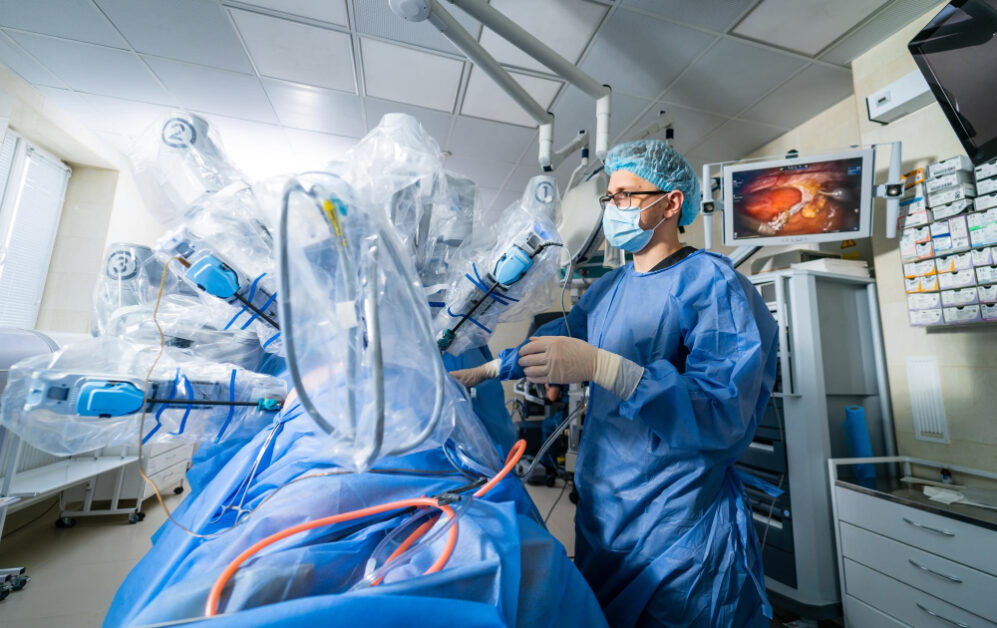
TrendVisionz is at the forefront of discovering how innovation is redefining India’s healthcare future. We study and research how technology drive measurable change in healthcare delivery. Working with government departments and leading corporations gives us access to emerging insights.
India is growing focus on digital transformation and AI adoption. In this in-depth feature, we highlight the broader evolution of innovation in healthcare. Also explore how early adoption is shaping the next generation of healthcare professionals. Want to know how India heals, learns, and leads in modern medicine? Read on.
Also Read:
- Cervical Cancer Prevention in India: Screening and HPV Vaccination
- Nutrient Sequencing: A Smarter Way to Eat for Energy, Focus, and Health
The Rise of AI and Robotics in Indian Healthcare
AI and robotics have moved from research labs into mainstream hospital settings across India. They now drive accuracy in diagnostics, surgery, and daily operations, improving both care delivery and patient recovery.
Artificial intelligence uses computer systems to analyze medical data, assist decision-making, and predict outcomes. Robotics applies this intelligence to physical tools that help surgeons perform precise, minimally invasive procedures and assist hospitals in automating complex tasks.
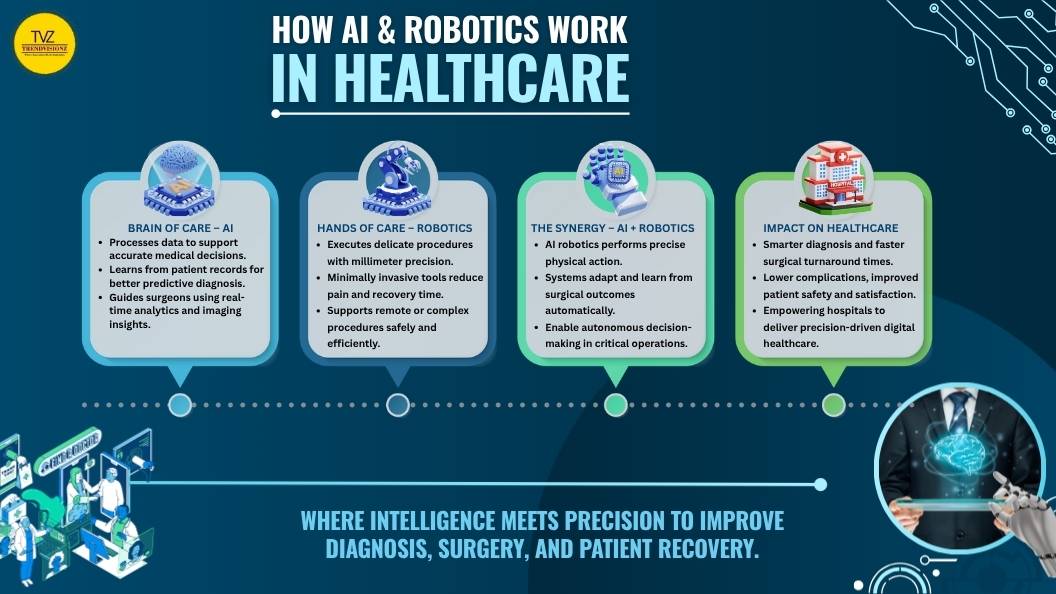
AI in Diagnostics and Surgery
Artificial intelligence in medicine is enhancing how diseases are identified and treated. AI tools process large data sets quickly, helping doctors make faster and more accurate decisions.
- Narayana Health uses AI to interpret echocardiograms for early cardiac diagnosis in remote settings.
- Aravind Eye Hospitals partner with Google to scan retinal images and detect diabetic retinopathy at scale.
AI-driven systems are also assisting pathologists, radiologists, and oncologists in analyzing scans, predicting outcomes, and reducing errors. The result is earlier detection, quicker treatment, and improved patient confidence.
Watch how Indian hospitals are using robotics and tele-surgery to bring precision and access to patients across geographies.
Robotics Driving Surgical Precision
Robotic surgery2 has evolved rapidly since 1985, when the first surgical robot, Puma 560, was introduced (TechSci Research). What began as a precision-driven experiment has become a cornerstone of modern medicine, transforming patient safety, surgical accuracy, and recovery outcomes.
India is one of the fastest-growing markets for surgical robotics, expected to reach nearly $4 billion by 2031. This reflects a sharp rise in adoption and technological advancement across major hospitals.

India’s surgical robotics landscape is supported by a mix of global leaders and domestic innovators. Leading companies supplying surgical robots include Intuitive Surgical (U.S.), Medtronic (American-Irish), and CMR Surgical (U.K.), which have partnered with several Indian hospitals to expand access to advanced systems.
Homegrown manufacturer SS Innovations (SSI) has emerged as a key player, producing India’s first indigenously designed surgical robot, Mantra, aimed at making robotic surgery more affordable and accessible across Tier-2 and Tier-3 cities.
Robots assist surgeons in performing minimally invasive procedures with millimeter accuracy and reduced fatigue.
- JJ Group of Hospital in Mumbai completed more than 100 robotic procedures in three months, improving surgical outcomes and recovery time.
- Meril Life Sciences has introduced indigenous robotic joint systems that help pre-plan procedures and ensure uniform precision.
For patients, this means smaller incisions, shorter hospital stays, and faster rehabilitation. For surgeons, it means enhanced control and consistency during complex procedures.
The setup looks somewhat like a scene from a sci-fi movie, and the outcomes are so good that a large number of patients are now realising its benefits,” Senior Robotic Surgeon. AIIMS, New Delhi.
Beyond the Operation Table – The Expanding Impact of Robotic Surgery
Robotic surgery is more than a clinical advancement; it’s transforming entire healthcare systems. From improved patient outcomes3 to cost savings and surgeon well-being, the ripple effects extend far beyond the operating room. Here’s how this innovation is redefining modern medicine in measurable ways.
- Lower Infection Rates: Minimally invasive incisions reduce surgical-site infections by up to 50%.
- Shorter Hospital Stays: Patients recover faster, cutting stay durations by 20–25%.
- AI-Enhanced Precision: Real-time imaging and motion tracking improve tumor excision accuracy.
- Reduced Readmissions: Fewer complications mean lower post-surgery hospital returns.
- Surgeon Well-Being: Ergonomic consoles4 reduce fatigue and musculoskeletal strain.
- Efficient Training: AR-integrated simulators speed up surgical learning by 30%.
- Higher Patient Confidence: Hospitals offering robotic procedures see 40% higher preference rates.
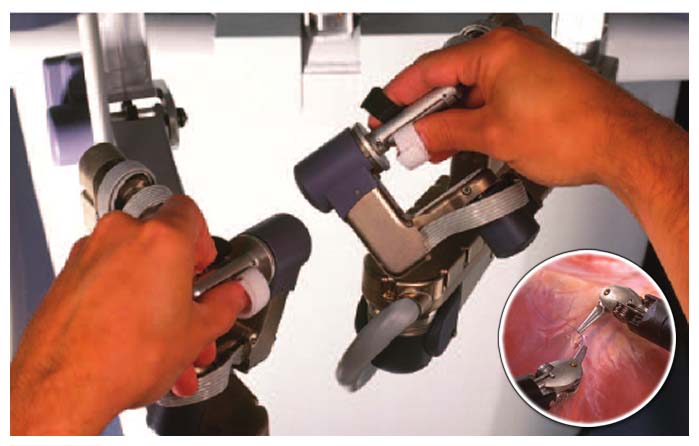
Robotic surgery’s benefits extend beyond precision. It accelerates recovery, reduces complications, optimizes hospital resources, and enhances surgeon performance. Supported by AI integration, it’s setting new benchmarks in patient safety, institutional efficiency, and the long-term sustainability of healthcare systems.
Key Statistics (2024–2025)
India’s adoption of robotic surgery is accelerating, marked by rising installations, trained surgeons, and growing nationwide demand for precision healthcare.
- Annual robotic surgeries: Over 10,000 procedures in 2024, reaching around 12,800 by late 2025.
- Robotic surgery installations: More than 100 systems operational nationwide.
- Trained surgeons: Approximately 800–850 certified robotic surgeons in India.
- Specialty focus: Majority in urology, gynecology, oncology, and cardiothoracic fields across major metro hospitals.
- Annual growth: Expanding at 10–18% CAGR, supported by government initiatives and rising medical tourism demand.
(Source: Industry analysis reports, 2025)
India’s growing adoption of robotic surgery reflects more than numbers—it signals a shift in clinical confidence and capability. This steady mainstreaming of technology is positioning India among global leaders in precision-driven surgery.
Close to 30% of complicated surgeries performed in India now use robotic systems for minimal invasion and precision. This places the nation almost on a par with developed countries – Dr Ajay Narasimhan, Apollo Hospitals, Chennai
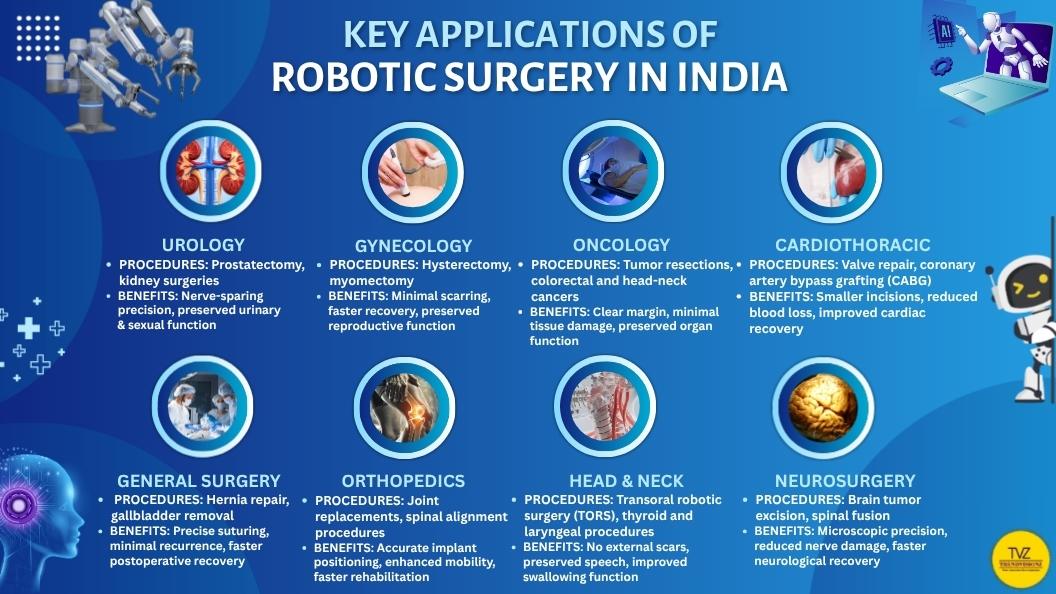
A Growing Market of Innovation
The healthcare industry is entering a new phase of rapid transformation. Advancements in AI, robotics, telemedicine, and biotechnology are driving innovation and creating large-scale opportunities across clinical and research sectors. The global digital healthcare market, valued at $180 billion in 2023, is projected to reach $550 billion by 2028.
Key Drivers of Growth:
- AI and machine learning enable smarter diagnostics, drug discovery, and personalized treatments.
- Robotics and VR improve surgical precision and medical training.
- Telemedicine and wearables expand access and real-time monitoring.
- Biotech and 3D printing power next-generation therapies and devices.
Trendvisionz’s healthcare insights indicate that Indian hospitals and med-tech startups are well-positioned to capture this growth.
Together, these advancements mark a defining shift in healthcare. India’s integration of AI and robotics is building a system that is smarter, more accessible, and ready for a technology-driven future.
Early Integration in Medical Education – Training the Next-Gen Surgeons
Indian medical schools are introducing robotic labs and AI simulators that allow students to practice complex procedures long before they enter real operating rooms. This early exposure helps bridge the gap between theoretical learning and hands-on clinical experience.
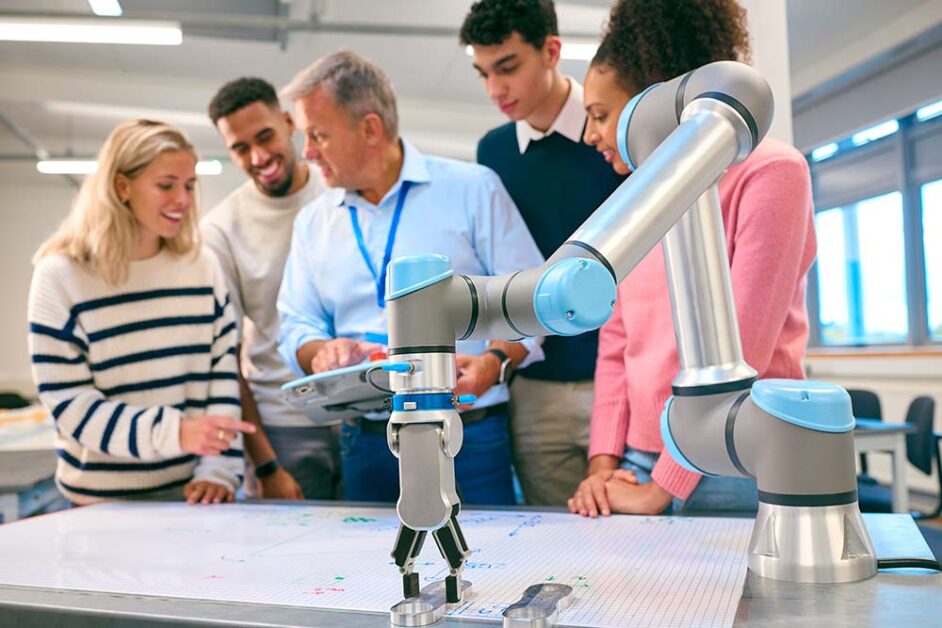
Building Technical and Cognitive Skills
AI in medical education is reshaping how students develop precision, confidence, and adaptability. These systems enhance hand–eye coordination, improve decision-making under pressure, and teach controlled precision—skills that define modern surgeons.
- AIIMS and Manipal University using robotic simulators to train students in real-time surgical techniques.
- Simulation-based modules where learners perform repetitive procedures until accuracy improves.
A senior oncology and robotic surgery specialist at Fortis Memorial Research Institute, share her experience,
“Many times, there’s reluctance among surgeons to learn a new skill, but considering the benefits it brings to patients, I feel surgeons must adopt this technology for the patients’ sake.”- Dr Rama Joshi
Virtual reality and augmented reality are now creating digital labs where students simulate full surgeries in safe, controlled environments.
Technology Beyond Simulation
Virtual reality and augmented reality are creating digital labs where students can simulate full surgeries in a safe, controlled environment. AR overlays real anatomy with virtual guidance, allowing learners to visualize incisions and movements with exact accuracy.
The Impact of Early Integration
This early training builds a generation of data-literate, tech-ready professionals who can adapt to emerging technologies in hospitals. Dr. M. Srinivas, Director of AIIMS, notes,
Students trained on simulation systems show higher procedural accuracy and reduced learning curves.
Our research shows that institutions adopting AI-driven surgical simulation produce graduates with stronger practical skills and faster on-the-job adaptability. It is preparing India’s healthcare workforce for a digital future.
How Government Programs Are Accelerating Digital Transformation
India’s digital health revolution is being shaped by strong government policies that promote innovation, inclusion, and technology-led care. These initiatives are ensuring that AI, robotics, and data-driven tools reach hospitals, clinics, and rural health centers alike.
Ayushman Bharat Digital Mission (ABDM)
The Ayushman Bharat Digital Mission is building the foundation for a connected healthcare ecosystem. With over 73 crore citizens registered under the Ayushman Bharat Health Account (ABHA). India now has one of the world’s largest digital health networks. The system enables seamless sharing of electronic health records (EHRs), making patient data accessible, secure, and ready for AI integration in diagnostics and treatment.
National Health Authority and Centers of Excellence
The National Health Authority (NHA) is leading the adoption of AI for fraud detection, data analytics, and transparency in health programs. It also supports the creation of Centers of Excellence for AI in Healthcare that encourage research, pilot projects, and public–private collaborations focused on diagnostics, robotics, and predictive analytics.
Expanding Rural Reach through eSanjeevani
Telemedicine platforms like eSanjeevani are bridging healthcare access gaps in rural India. As per the Ministry of Health & Family Welfare, India’s eSanjeevani platform has facilitated over one lakh tele-consultations. The platform is empowering patients across rural and urban regions to access timely specialist care from home.

“I dream of a Digital India where quality healthcare percolates right up to the remotest regions powered by e-Healthcare.” — Shri Narendra Modi, Hon’ble Prime Minister of India
Public hospitals performing robotic pediatric surgeries are a reflection of how policy meets practice. It is driving inclusivity through innovation and helping India move toward a digitally empowered healthcare system.
Efficiency and ROI – The Practical Gains of AI Integration
Beyond innovation, AI-driven automation is delivering measurable efficiency that strengthens India’s healthcare system. Hospitals adopting digital tools now record clear improvements in time management, accuracy, and cost optimization.
How AI Improves Efficiency in Indian Hospitals
| Application Area | Example / Institution | Measured Impact | Outcome |
| Clinical Documentation | Apollo Hospitals, Chennai | 2–3 hours saved daily per clinician | More time for patient care |
| Surgical Scheduling | Narayana Health, Bengaluru | 20% faster pre-operative planning | Reduced patient waiting time |
| Nursing & Administration | Fortis Healthcare (pilot) | 15% reduction in overtime hours | Lower fatigue, better efficiency |
| AI Decision Support | AIIMS Delhi (pilot phase) | 30% faster diagnostic turnaround | Early detection, improved accuracy |
“Clinician time in India is estimated at ₹535 per hour, making every saved hour through automation a measurable financial return for hospitals”

This estimate is derived from our industry market research and validated through case studies at leading institutions such as Apollo and Narayana Health. It is clear now that AI-enabled systems are reducing burnout, improving workflow speed, and lowering operational costs.
Automation in hospitals is saving thousands of clinician hours each year, allowing healthcare professionals to focus on what matters most, patient care.
Expanding Access – Bridging India’s Urban–Rural Healthcare Gap
AI and robotics are breaking geographical barriers in Indian healthcare. By linking smaller towns and rural regions with advanced medical centers, these technologies are ensuring that access to quality treatment no longer depends on geography.
Extending Specialist Reach
AI hospitals in India are using digital networks to bring advanced care closer to underserved communities. Robotic systems combined with real-time data transfer allow surgeons to guide complex procedures from major hospitals, improving precision and patient outcomes in regional facilities.
Smarter Diagnostics Across Distances
AI-driven diagnostic platforms are transforming how healthcare reaches remote regions. They link doctors, data, and patients in real time. The systems enable faster diagnosis, early detection, and better treatment outcomes. Thus bridging the healthcare gap between urban hospitals and rural communities.
- Apollo Hospitals runs one of India’s largest AI-based “tele-health” networks, interpreting scans from remote areas within hours.
- Wadhwani Institute for AI supports state maternal health programs that use predictive analytics to identify pregnancy risks early.
- Narayana Health integrates AI tools in outreach camps to detect cardiac anomalies and refer high-risk patients to specialists.
These innovations are improving early detection, reducing travel burdens, and ensuring timely interventions.
Technology is not just saving time—it’s saving lives by extending expert care to places where specialists are scarce.
The Future of Digital Healthcare and Collaboration
India’s healthcare transformation is entering its next chapter, where innovation, education, and collaboration define a sustainable digital future. Hospitals, startups, and policymakers are working together to ensure that technology remains human-centered, ethical, and accessible to all.
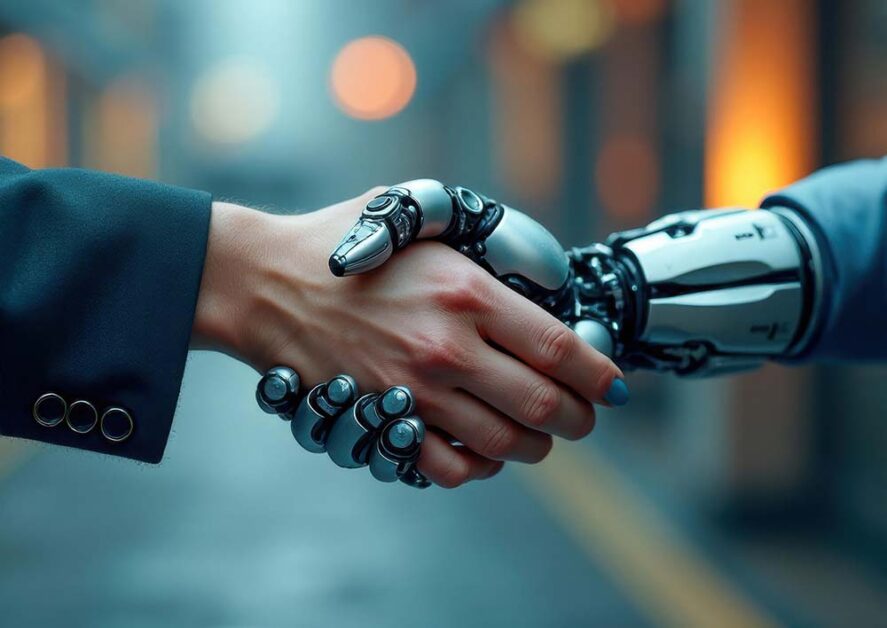
Collaboration and Innovation Networks
Collaboration between universities, startup and public health agencies is creating an integrated digital health ecosystem. Academic institutions are aligning with the nation’s broader push toward AI in education initiatives. These collaborations strengthen both healthcare innovation and digital learning outcomes.
Indigenous Robotics and Local Manufacturing
The growth of indigenous robotics and local med-tech manufacturing marks a shift toward self-reliance. Companies developing surgical robots, wearable monitoring systems, and AI-based diagnostic devices are positioning India as a global hub for affordable innovation.
Preparing the Next Generation
AI-based medical curricula are training future surgeons, clinicians, and healthcare managers to use data and technology responsibly. QS World University Rankings place greater focus on innovation and digital learning, pushing medical schools to include digital health education.
Collaborative partnerships are now driving India’s leadership in healthcare innovation. The country’s digital health journey is evolving from adoption to global influence—powered by continuous learning and a shared vision for accessible, technology-enabled care.
Also Read:
- The Protein Market in India Is Exploding—Here’s What You Need to Know in 2025
- Modern Nutrition Redefined: Nourish Your Body, Mind & Soul to Truly Flourish
FAQ: AI and Robotics
How are AI and robotics improving patient care in India?
AI and robotics improve patient care by enhancing diagnostic accuracy, reducing surgical errors, supporting real-time monitoring, and expanding access through telemedicine. They enable faster, safer, and more personalized treatment across hospitals and healthcare networks.
What is the Da Vinci Robotic Surgery System?
The Da Vinci system is a computer-assisted surgical platform that translates a surgeon’s hand movements into precise actions by robotic arms. It enhances vision, dexterity, and control during minimally invasive procedures such as prostatectomy, hysterectomy, and cardiac surgery.
What sets robotic-assisted surgery (RAS) apart from traditional laparoscopic surgery?
RAS offers 3D visualization, superior hand–eye coordination, and precise instrument control through robotic arms. Surgeons operate using a console for better accuracy, while patients experience smaller incisions, less pain, minimal blood loss, and faster recovery.
Conclusion
AI and robotics are transforming healthcare delivery across India. What began as innovation in labs is now reshaping how hospitals heal, teach, and connect communities. From early adoption and digital education to supportive government policies, the integration of AI has improved efficiency, inclusion, and collaboration across healthcare systems.
India is emerging as a global leader in digital healthcare innovation, combining technology with empathy to create patient-centric, ethical, and sustainable solutions.
The future of healthcare lies in harmony between human skill and intelligent systems, where India leads with purpose, innovation, and compassion.
Additional Resources:
- Bain & Company. (2024). Healthcare Innovation in India. Retrieved from https://www.bain.com/insights/healthcare-innovation-in-india/ ↩︎
- Desai M, Chabra J, Ganpule AP. Robotic surgery is ready for prime time in India: For the motion. J Minim Access Surg. 2015 Jan-Mar;11(1):2-4. doi: 10.4103/0972-9941.147649. PMID: 25598591; PMCID: PMC4290113. ↩︎
- Rivero-Moreno Y, Echevarria S, Vidal-Valderrama C, Pianetti L, Cordova-Guilarte J, Navarro-Gonzalez J, Acevedo-Rodríguez J, Dorado-Avila G, Osorio-Romero L, Chavez-Campos C, Acero-Alvarracín K. Robotic Surgery: A Comprehensive Review of the Literature and Current Trends. Cureus. 2023 Jul 24;15(7):e42370. doi: 10.7759/cureus.42370. PMID: 37621804; PMCID: PMC10445506. ↩︎
- Panaiyadiyan, S., & Kumar, R. (2022). Outcomes of Robotic Surgery for Low-Volume Surgeons. Société Internationale d’Urologie Journal, 3(5), 323-330. https://doi.org/10.48083/PPSC8658 ↩︎
Stay Connected with Me:
Anuj Mahajan is a Mass Communication Specialist, ICF-ACC Certified Coach, Corporate Trainer, Motivational Speaker, NLP Life Coach, Filmmaker, and Author. With 30+ years in media, marketing, and leadership coaching, he unites storytelling, mindfulness, and digital transformation.
- Explore my work: Nuteq Entertainment | TrendVisionz | Author Profile
- Read our newsletters: Transforming Lives | BizTech Chronicle | Nuteq Newsline
- Guest writer: BizCatalyst360 | Praja Today
- Books: Go Mindfulness: Practices for Professionals Coached
- Join the community: LinkedIn Group – Digital Marketing & Content Creation World
- Connect with me: LinkedIn | Twitter | #StoryforBusiness
- Share your review: Leave your review on Google — your feedback helps us grow.
- Listen on Spotify: Leadership Podcast | Guided NLP (7 Episodes) | Daily Motivation – 21 Episodes
Believe. Practice. Perform. Let’s create impact together.
✍️ A Note from the Editor
Independent storytelling thrives with you. Contribute $15/month via PayPal or email us at anujmahajan@trendvisionz.com. [Guest write for us — Free or Paid.]



2 comments
[…] Posts AI & Robotics: How Early Integration Is Shaping Modern Healthcare How Engineered Trust is Redefining Global OEM Partnerships निरंकार शिव: […]
[…] Posts AI & Robotics: How Early Integration Is Shaping Modern Healthcare How Engineered Trust is Redefining Global OEM Partnerships निरंकार शिव: […]